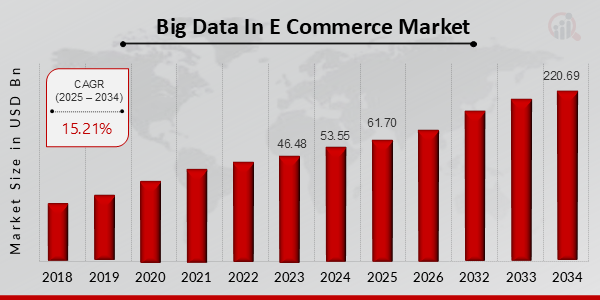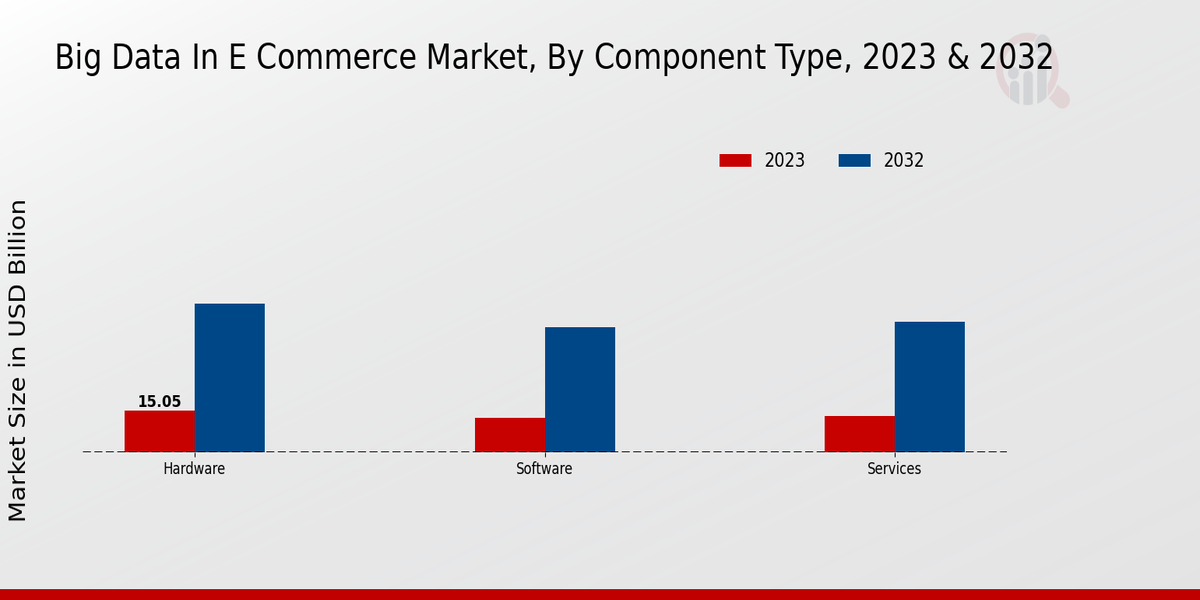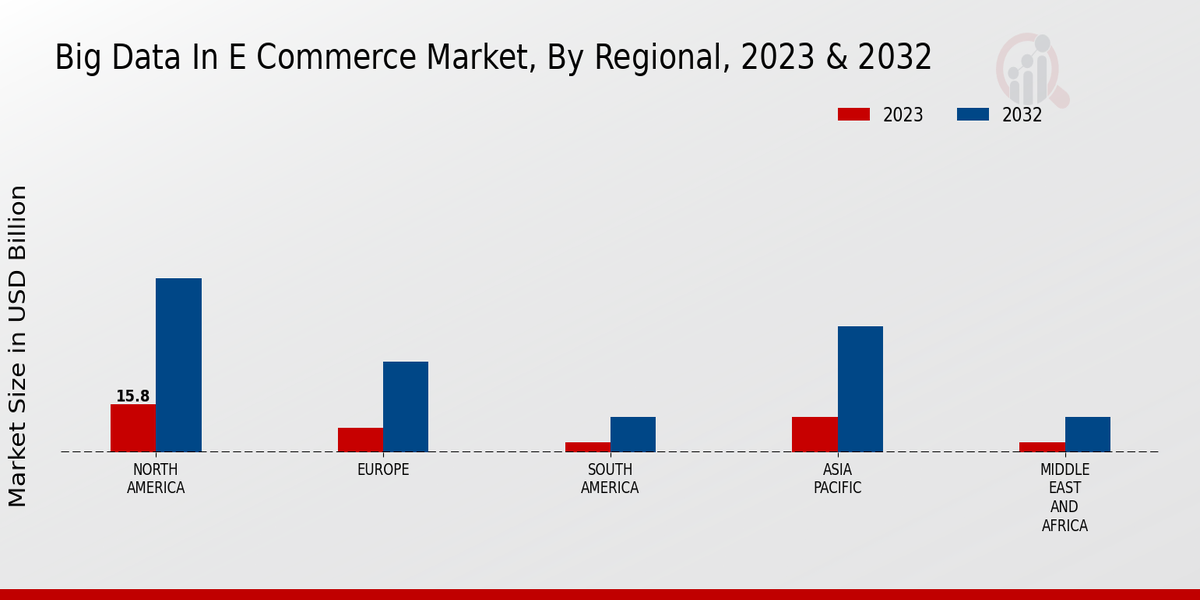Big Data In E-Commerce Market Overview
Big Data In E Commerce Market is projected to grow from USD 61.70 Billion in 2025 to USD 220.69 Billion by 2034, exhibiting a compound annual growth rate (CAGR) of 15.21% during the forecast period (2025 - 2034).
Additionally, the market size for Big Data In E Commerce Market was valued at USD 53.55 billion in 2024.
Key Big Data In E-Commerce Market Trends Highlighted
Key market drivers include the rapid growth of e-commerce, the increasing adoption of cloud computing and data analytics, and the growing need for businesses to improve customer experience and personalization. Opportunities exist in the development of new technologies and solutions to address challenges such as data security, privacy, and governance.Recent trends include the adoption of real-time data analytics, the use of artificial intelligence and machine learning to enhance data analysis, and the emergence of new data sources such as social media and IoT devices. These trends are driving innovation and creating opportunities for businesses to unlock new insights and drive growth.
Figure 1: Big Data In E-Commerce Market size 2025-2034

Source: Primary Research, Secondary Research, MRFR Database and Analyst Review
Big Data In E-Commerce Market Drivers
Rising Adoption of Cloud-Based Big Data Solutions
One of the driving forces for the growth of Big Data In E-Commerce Market Industry is the increasing adoption of cloud-based big data solutions. Businesses can benefit from the use of cloud-based solutions in a number of ways, including their scalability, flexibility and cost-effectiveness. Moreover, as more businesses are using the cloud to store their data and run their applications, the demand for big data solutions will continue to rise.
Apart from the benefits mentioned above, cloud-based big data solutions can help businesses to improve their security and compliance. Owing to the security features that are offered by cloud providers, businesses can reduce the risk of their data being breached and ensure that their data is compliant with regulations. On the whole, the increasing adoption of cloud-based big data solutions is one of the driving forces of the growth of Big Data In the E-Commerce Market Industry as a whole.
Increasing Use of Data Analytics for Business Intelligence
The use of data analytics for business intelligence is likely to be another key growth driver of the Big Data In E Commerce Market Industry. Businesses are increasingly using data analytics to understand their customers, businesses and markets. This will be lucrative for businesses to use the information to make better decisions and become more proficient and profitable. It can be used in different ways, for example, to establish the latest market needs and trends for clients, to further a technology marketing strategy, to also offer customers useful applications, to help build more efficient and cost-effective operations etc.As the volume of data available to enterprises has increased, it will continue to fuel the growth of data analytics demand from time to time.
Growing Need for Real-Time Data Processing
The first driver of growth in the Big Data In E Commerce Market Industry is the rapidly growing demand for real-time data processing. When it comes to data processing, timing is everything. Businesses need to be able to process data in real-time if they want to keep up with the demands of their customers and the market. This is especially important in fast-paced industries like e-commerce and financial services.
However, not all businesses are equipped to deal with the challenges associated with real-time data processing.These challenges include the need for high-performance computing systems, the need for scalable and reliable data storage solutions, and the need for expertise in data engineering and data science. As a result, the demand for real-time data processing is growing faster than the supply, which presents a major opportunity for businesses that can provide innovative real-time data processing solutions.
Big Data In E-Commerce Market Segment Insights
Big Data In E-Commerce Market Component Type Insights
The Big Data In E Commerce Market is segmented by Component Type into Hardware, Software, and Services. The Hardware segment is expected to account for the largest market share in 2023, owing to the increase in the demand for high-performance computing systems and data storage solutions. The Software segment is expected to grow at the highest CAGR during the forecast period, owing to the rise in the adoption of big data analytics solutions and the increasing need for data management and processing capabilities. The Services segment is expected to account for a significant market share, owing to the increase in the demand for data consulting, implementation, and support services.
In 2023, the Big Data In E-Commerce Market for Hardware is expected to be valued at USD 15.05 billion and is projected to reach USD 53.04 billion by 2032, growing at a CAGR of 10.7%. The Software segment is expected to be valued at USD 12.45 billion in 2023 and is projected to reach USD 44.647 billion by 2032, growing at a CAGR of 12.1%. The Services segment is expected to be valued at USD 12.85 billion in 2023 and is projected to reach USD 46.594 billion by 2032, growing at a CAGR of 11.8%. The growth of the Big Data In E-Commerce Market is attributed to the increase in the adoption of big data technologies by e-commerce companies to enhance customer experience, streamline operations, and gain competitive advantage.
The surge in the need for data-driven insights to make better decisions is also a key factor driving the market growth. The rising availability of data from a variety of sources, such as customer transactions, social media, and IoT devices, is further boosting the market growth. The market is defined by the presence of several key players, such as IBM, Oracle, Microsoft, SAP and Google. These players offer a range of big data solutions and services to cater to the needs of e-commerce companies. The market is also witnessing the presence of many new entrants, which offer innovative solutions and services to meet the growing demand for big data in e-commerce.

Source: Primary Research, Secondary Research, MRFR Database and Analyst Review
Big Data In E-Commerce Market Deployment Type Insights
Based on deployment type, the Big Data In E-Commerce Market is segmented into cloud, on-premise and hybrid. Among these, the cloud segment is expected to hold the largest market share during the forecast period. The growth of the cloud segment can be attributed to the increasing adoption of cloud-based solutions by e-commerce businesses, as they are scalable, cost-effective, and flexible. The on-premise segment is expected to have a steady growth rate during the forecast period, as some businesses prefer on-premise deployments for security and data control concerns.
The hybrid segment is expected to have substantial growth in the upcoming years as businesses look to benefit from both cloud and on-premise deployments. In 2023, the Big Data In E-commerce Market for cloud deployment was valued at USD 14.23 billion and is anticipated to reach USD 38.45 billion by 2032 at a CAGR of 12.1% during the forecast period. The on-premise segment is expected to grow from USD 10.32 billion in 2023 to USD 25.68 billion by 2032 at a CAGR of 11.2%. The hybrid segment is forecasted to expand from USD 5.8 billion in 2023 to USD 15.87 billion by 2032 at a CAGR of 12.9%.
Big Data In E-Commerce Market Application Insights
The application segment of the Big Data in E-commerce Market holds significant potential for growth, driven by the increasing adoption of big data technologies to enhance customer experiences and optimize business operations. Among the key applications, Customer Analytics emerged as a dominant segment, accounting for a substantial portion of the Big Data in E-commerce Market revenue in 2023. Inventory Optimization is another vital application, enabling businesses to streamline their supply chains and reduce costs.
It is projected to grow at a CAGR of 14.3% from 2023 to 2032.Fraud Detection is a crucial application, helping e-commerce companies safeguard their revenue by identifying and preventing fraudulent transactions. This segment is expected to grow at a CAGR of 13.9% over the forecast period. Pricing and Promotions and Product Recommendations are additional significant applications in the Big Data in E-commerce Market, contributing to revenue growth and enhancing customer engagement.
Big Data In E-Commerce Market Vertical Insights
The Big Data In E-Commerce Market revenue is segmented into various verticals, including Retail, Manufacturing, Healthcare, Financial Services and Transportation and Logistics. Among these, the Retail vertical held the largest market share in 2023, accounting for approximately 35%. This dominance is attributed to the increasing adoption of big data analytics by retailers to enhance customer experience, optimize supply chains and personalize marketing campaigns.
The Manufacturing vertical is projected to witness significant growth during the forecast period, driven by the need for data-driven decision-making to improve production efficiency, optimize inventory management and enhance product quality.The Healthcare vertical is also anticipated to grow steadily, as big data plays a crucial role in personalized medicine, drug discovery, and healthcare analytics. Financial Services, Transportation, and Logistics are other key verticals that are expected to contribute to the overall growth of the Big Data In the E-Commerce Market in the coming years.
Big Data in E-Commerce Market Data Source Insights
The data Source segment plays a pivotal role in the Big Data In E-Commerce Market, shaping market growth and offering valuable insights into customer behavior, preferences, and trends. Among the key data sources in this segment are: Customer Data: This data encompasses customer demographics, purchase history, browsing behavior and preferences. It helps businesses understand their customer base, personalize marketing campaigns and improve customer engagement.
Transaction Data: This data includes details of every transaction made on an e-commerce platform, such as order value, payment method, and shipping address.It provides insights into customer spending patterns, popular products, and potential areas for optimization. Product Data: This data includes information about products sold on e-commerce platforms, such as product descriptions, specifications, and pricing. It helps businesses manage their inventory, optimize product listings, and identify cross-selling and up-selling opportunities.
Social Media Data: This data includes information from social media platforms, such as customer reviews, brand mentions, and influencer endorsements. It provides businesses with insights into customer sentiment, brand perception and emerging trends.IoT Data: This data is collected from IoT devices, such as smart sensors and connected appliances. It provides businesses with real-time insights into customer behavior, product usage and potential areas for innovation.
Big Data In E-Commerce Market Regional Insights
Regionally, North America is expected to hold the largest share of the market, followed by Europe, APAC, South America and MEA. The growth of the North American market is attributed to the presence of a large number of e-commerce companies, such as Amazon, Walmart, and eBay, as well as the increasing adoption of big data technologies by these companies. The European market is expected to grow due to the increasing adoption of big data technologies by e-commerce companies, such as Zalando and Asos, as well as the growing number of e-commerce shoppers in the region.
The APAC market is expected to grow due to the increasing adoption of big data technologies by e-commerce companies, such as Alibaba and JD.com, as well as the growing number of e-commerce shoppers in the region. The South American market is expected to grow due to the increasing adoption of big data technologies by e-commerce companies, such as Mercado Libre and Linio, as well as the growing number of e-commerce shoppers in the region. The MEA market is expected to grow due to the increasing adoption of big data technologies by e-commerce companies, such as Souq and Noon, as well as the growing number of e-commerce shoppers in the region.

Source: Primary Research, Secondary Research, MRFR Database and Analyst Review
Big Data in E-Commerce Market Key Players And Competitive Insights
Major players in Big Data In E-Commerce Market industry are continuously striving to enhance their strategies to gain a competitive advantage in the market. Leading Big Data In E-Commerce Market players are focusing on developing innovative solutions and expanding their reach to cater to the growing demand for Big Data In E-Commerce Market services. The Big Data In E Commerce Market industry is characterized by a highly competitive landscape, with several leading players vying for market share. These players are investing heavily in research and development to stay ahead of the curve and meet the evolving needs of customers.
Mergers and acquisitions are also a common strategy adopted by companies to expand their portfolio and gain access to new technologies and markets. Collaboration and partnerships with other industry players are also becoming increasingly important in the Big Data In E-Commerce Market industry as companies seek to leverage complementary strengths and offer comprehensive solutions to customers.Amazon Web Services (AWS) is a leading provider of cloud computing services, including Big Data and analytics solutions. The company offers a range of services that enable businesses to collect, store, process, and analyze data to gain insights and make informed decisions.
AWS has a strong presence and serves a diverse customer base across various industries. Google Cloud Platform (GCP) is another major player in the Big Data In E Commerce Market industry. The company provides a comprehensive suite of cloud services, including Big Data and analytics capabilities. GCP offers a variety of tools and technologies that enable businesses to manage and analyze data at scale. Google Cloud Platform has a strong track record of innovation and is known for its advanced artificial intelligence (AI) and machine learning capabilities.
Key Companies in the Big Data In E-Commerce Market Include
-
Dell Technologies
-
Informatica
-
IBM
-
Splunk
-
Google Cloud Platform
-
Amazon Web Services
-
Teradata
-
Alibaba Cloud
-
Cloudera
-
Microsoft Azure
-
SAP
-
Hortonworks
-
Oracle
-
Pivotal Software
Big Data In E-Commerce Market Industry Developments
The Big Data in E-commerce Market size was valued at USD 22.16 billion in 2023 and is expected to expand at a compound annual growth rate (CAGR) of 15.21% from 2024 to 2032. The market growth is attributed to the increasing adoption of big data analytics to gain insights into customer behavior, optimize marketing campaigns, and improve supply chain management.Recent news developments and current affairs in the market include the launch of new big data analytics platforms and solutions by major technology providers like IBM, Microsoft, and SAP.
Additionally, e-commerce companies are increasingly investing in big data initiatives to improve their customer experience and drive sales. For instance, Amazon Web Services (AWS) has launched a new service called "Amazon Personalize" that uses machine learning to create personalized recommendations for e-commerce customers.
Big Data in E-Commerce Market Segmentation Insights
-
Big Data In E-Commerce Market Component Type Outlook
-
Hardware
-
Software
-
Services
-
Big Data In E-Commerce Market Deployment Type Outlook
-
Big Data In E-Commerce Market Application Outlook
-
Customer Analytics
-
Inventory Optimization
-
Fraud Detection
-
Pricing and Promotions
-
Product Recommendations
-
Big Data In E-Commerce Market Vertical Outlook
-
Big Data In E-Commerce Market Data Source Outlook
-
Customer Data
-
Transaction Data
-
Product Data
-
Social Media Data
-
IoT Data
-
Big Data In E-Commerce Market Regional Outlook
-
North America
-
Europe
-
South America
-
Asia Pacific
-
Middle East and Africa
|
Report Attribute/Metric
|
Details
|
|
Market Size 2024
|
53.55 (USD Billion)
|
|
Market Size 2025
|
61.70 (USD Billion)
|
|
Market Size 2034
|
220.69 (USD Billion)
|
|
Compound Annual Growth Rate (CAGR)
|
15.21% (2025 - 2034)
|
|
Report Coverage
|
Revenue Forecast, Competitive Landscape, Growth Factors, and Trends
|
|
Base Year
|
2024
|
|
Market Forecast Period
|
2025 - 2034
|
|
Historical Data
|
2019 - 2023
|
|
Market Forecast Units
|
USD Billion
|
| Key Companies Profiled |
Dell Technologies, Informatica, IBM, Splunk, Google Cloud Platform, Amazon Web Services, Teradata, Alibaba Cloud, Cloudera, Microsoft Azure, SAP, Hortonworks, Oracle, Pivotal Software |
| Segments Covered |
Component Type, Deployment Type, Application, Vertical, Data Source, Regional |
| Key Market Opportunities |
Personalized customer experiences Improved product recommendations Fraud detection and prevention Inventory optimization Dynamic pricing |
| Key Market Dynamics |
Growing adoption of cloud-based solutions Increasing demand for personalized marketing Rising adoption of AI and ML technologies Emergence of advanced analytics platforms Expanding e-commerce industry |
| Countries Covered |
North America, Europe, APAC, South America, MEA |
Frequently Asked Questions (FAQ) :
The Big Data in E-Commerce Market was estimated to be worth USD 40.35 Billion in 2023.
The Big Data in E-Commerce Market is projected to reach USD 220.69 Billion by 2034
The Big Data in E-Commerce Market is expected to grow at a CAGR of 15.21% from 2025 to 2034
North America is expected to hold the largest market share in the Big Data in E-Commerce Market in 2023.
Customer Analytics is expected to account for the largest market share in the Big Data in E-Commerce Market in 2023.
Some of the key competitors in the Big Data in E Commerce Market include IBM, Oracle, Microsoft, SAP, and SAS.
The growth of the Big Data in E-Commerce Market is being driven by factors such as the increasing adoption of e-commerce, the growing volume of data generated by e-commerce transactions, and the need for businesses to gain insights from this data to improve their operations.
Some of the challenges facing the Big Data in E Commerce Market include the lack of skilled professionals, the high cost of implementing big data solutions, and the concerns about data privacy and security.
The opportunities for growth in the Big Data in E-Commerce Market include the development of new big data technologies, the increasing adoption of cloud-based big data solutions, and the growing demand for big data analytics from businesses of all sizes.
Some of the key trends in the Big Data in E Commerce Market include the increasing adoption of artificial intelligence (AI) and machine learning (ML), the growing popularity of real-time analytics, and the emergence of new big data applications.

















